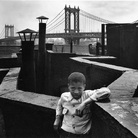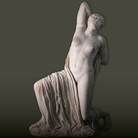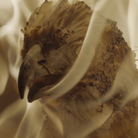Cavalli Celesti. Raffigurazioni equestri nella Cina antica

Cavaliere corazzato e con faretra su cavallo bianco terracotta grigia, ingobbio, pigmenti stesi a freddo 28,4 x 28,3 x 11,8 cm. Cina, Shaanxi Han Occidentali, II secolo a.C. Proprietà Compagnia di San Paolo
Dal 21 November 2014 al 22 February 2015
Torino
Luogo: MAO - Museo di Arte Orientale
Indirizzo: via San Domenico 11
Orari: da martedì a domenica 10-18
Costo del biglietto: intero € 10, ridotto € 8, gratuito fino ai 18 anni e abbonati Musei Torino Piemonte
Telefono per informazioni: +39 011 4436927
E-Mail info: mao@fondazionetorinomusei.it
Sito ufficiale: http://www.maotorino.it
I cavalli sono stati un simbolo di status sociale forte per l’élite cinese di ogni epoca e uno dei soggetti più rappresentati nell’arte della Cina imperiale. Emblemi di nobiltà, eleganza, velocità e potenza, si sono arricchiti nel corso del tempo di valenze soprannaturali ammantate di resoconti leggendari. Tra i più famosi di questi miti troviamo quello dei “Cavalli Celesti”, straordinari destrieri capaci di trasportare chi li cavalcava nelle terre degli immortali. In occasione dell’Anno del Cavallo, il Museo d’Arte Orientale intende omaggiare questa creatura che tanto peso ha avuto nella storia dei popoli con una mostra ad essa dedicata.
Attraverso quarantacinque opere provenienti dalle collezioni del museo e da una collezione privata torinese, la mostra esplora l’importanza della figura del cavallo nell’arte e nella cultura della Cina antica con spettacolari statuine funerarie a tutto tondo nel periodo che va dalla dinastia Han (206 a.C. – 220 d.C.) alla dinastia Tang (618-907 d.C.), elementi arcaici di bardature e di carri (XI sec. a.C. – II sec. d.C.), rilievi e ceramica dipinta (II sec. a.C. – I sec. d.C.). Si tratta in gran parte di sculture in terracotta dipinta e invetriata, dove i cavalli appaiono soli o in rapporto dinamico con il cavaliere, colorati e arricchiti di dettagli a seconda della funzione che l'immagine doveva evocare e rendere viva.
Il percorso espositivo è articolato in sette sezioni che corrispondono a diversi ambiti tematici: dalla guerra, al commercio, allo svago, fino alla evoluzione delle forme tra gli Han e i Tang. Molti sono gli aspetti di storia e di civiltà che si intrecciano a questo itinerario. Per esempio, a partire dalla fine del IV secolo a.C., l'adozione della cavalleria, fondamento per la costituzione dell'Impero; l’apertura della cosiddetta “Via della Seta” sotto la dinastia Han (206 a.C. – 220 d.C.), che ebbe tra i suoi motori principali la ricerca nelle regioni occidentali di cavalli più grandi e più potenti; la diffusione di uno sport come il polo nel VII e VIII secolo; fino alle tecniche e alla concezione plastica, che vanno dalla stilizzazione potente dell’epoca Han al naturalismo idealizzato dei Tang, passando attraverso l’eleganza quasi pittorica dell’arte “medievale” nel VI secolo.
L'anno del cavallo nel calendario cinese Nel calendario tradizionale dell’Asia orientale, basato su cicli di sessanta anni, il 2014 è il trentunesimo anno e cade proprio a metà del ciclo in corso: rappresenta quindi un cambiamento di fase, un nuovo inizio. Sempre secondo questo computo del tempo, il 2014 è prima di tutto l’anno caratterizzato dal segno “zodiacale” del Cavallo e si colloca sotto l’influsso dell’elemento “Legno”, simbolo della primavera e del rinnovamento. Il cavallo è incarnazione di vivacità e vigore, ma anche di saggezza e talento, quindi l'anno sotto il suo segno è considerato ricco di forza vitale e di dinamismo.
Iniziative collaterali In occasione della mostra “Cavalli Celesti” saranno proposte conferenze e incontri di approfondimento con il pubblico, visite guidate dedicate, attività per scuole e famiglie. Gli appuntamenti andranno ad esplorare il significato del cavallo e delle sue raffigurazioni nella cultura cinese, tenendo in considerazione i raffronti con l’Occidente e con la Cina contemporanea.
Catalogo Il catalogo della mostra, pubblicato da Silvana Editoriale, è scritto da Marco Guglielminotti Trivel (Conservatore MAO per l’Asia orientale) con il contributo di Domenico Bergero (Direttore della Struttura Didattica Speciale Veterinaria dell’Università di Torino).
Attraverso quarantacinque opere provenienti dalle collezioni del museo e da una collezione privata torinese, la mostra esplora l’importanza della figura del cavallo nell’arte e nella cultura della Cina antica con spettacolari statuine funerarie a tutto tondo nel periodo che va dalla dinastia Han (206 a.C. – 220 d.C.) alla dinastia Tang (618-907 d.C.), elementi arcaici di bardature e di carri (XI sec. a.C. – II sec. d.C.), rilievi e ceramica dipinta (II sec. a.C. – I sec. d.C.). Si tratta in gran parte di sculture in terracotta dipinta e invetriata, dove i cavalli appaiono soli o in rapporto dinamico con il cavaliere, colorati e arricchiti di dettagli a seconda della funzione che l'immagine doveva evocare e rendere viva.
Il percorso espositivo è articolato in sette sezioni che corrispondono a diversi ambiti tematici: dalla guerra, al commercio, allo svago, fino alla evoluzione delle forme tra gli Han e i Tang. Molti sono gli aspetti di storia e di civiltà che si intrecciano a questo itinerario. Per esempio, a partire dalla fine del IV secolo a.C., l'adozione della cavalleria, fondamento per la costituzione dell'Impero; l’apertura della cosiddetta “Via della Seta” sotto la dinastia Han (206 a.C. – 220 d.C.), che ebbe tra i suoi motori principali la ricerca nelle regioni occidentali di cavalli più grandi e più potenti; la diffusione di uno sport come il polo nel VII e VIII secolo; fino alle tecniche e alla concezione plastica, che vanno dalla stilizzazione potente dell’epoca Han al naturalismo idealizzato dei Tang, passando attraverso l’eleganza quasi pittorica dell’arte “medievale” nel VI secolo.
L'anno del cavallo nel calendario cinese Nel calendario tradizionale dell’Asia orientale, basato su cicli di sessanta anni, il 2014 è il trentunesimo anno e cade proprio a metà del ciclo in corso: rappresenta quindi un cambiamento di fase, un nuovo inizio. Sempre secondo questo computo del tempo, il 2014 è prima di tutto l’anno caratterizzato dal segno “zodiacale” del Cavallo e si colloca sotto l’influsso dell’elemento “Legno”, simbolo della primavera e del rinnovamento. Il cavallo è incarnazione di vivacità e vigore, ma anche di saggezza e talento, quindi l'anno sotto il suo segno è considerato ricco di forza vitale e di dinamismo.
Iniziative collaterali In occasione della mostra “Cavalli Celesti” saranno proposte conferenze e incontri di approfondimento con il pubblico, visite guidate dedicate, attività per scuole e famiglie. Gli appuntamenti andranno ad esplorare il significato del cavallo e delle sue raffigurazioni nella cultura cinese, tenendo in considerazione i raffronti con l’Occidente e con la Cina contemporanea.
Catalogo Il catalogo della mostra, pubblicato da Silvana Editoriale, è scritto da Marco Guglielminotti Trivel (Conservatore MAO per l’Asia orientale) con il contributo di Domenico Bergero (Direttore della Struttura Didattica Speciale Veterinaria dell’Università di Torino).
SCARICA IL COMUNICATO IN PDF
COMMENTI

-
 Dal 2 December 2025 al 19 February 2026
Milano | Centro Culturale di Milano
Dal 2 December 2025 al 19 February 2026
Milano | Centro Culturale di Milano
Walter Rosenblum. Il mondo e la tenerezza
-
 Dal 30 November 2025 al 12 April 2026
Gallarate | Museo MA*GA
Dal 30 November 2025 al 12 April 2026
Gallarate | Museo MA*GA
Kandinsky e l’Italia
-
 Dal 29 November 2025 al 12 April 2026
Roma | Musei Capitolini
Dal 29 November 2025 al 12 April 2026
Roma | Musei Capitolini
La Grecia a Roma
-
 Dal 22 November 2025 al 3 May 2026
Torino | Sale Chiablese dei Musei Reali
Dal 22 November 2025 al 3 May 2026
Torino | Sale Chiablese dei Musei Reali
Orazio Gentileschi. Un pittore in viaggio
-
 Dal 20 November 2025 al 25 January 2026
Firenze | Palazzo Strozzi
Dal 20 November 2025 al 25 January 2026
Firenze | Palazzo Strozzi
Andro Eradze. Bones of Tomorrow
-
 Dal 21 November 2025 al 28 March 2026
Cuneo | Complesso Monumentale di San Francesco
Dal 21 November 2025 al 28 March 2026
Cuneo | Complesso Monumentale di San Francesco
La Galleria Borghese. Da Raffaello a Bernini. Storia di una collezione


